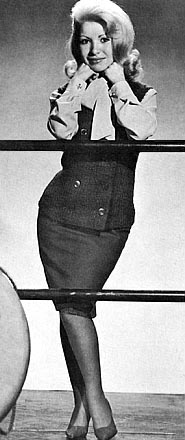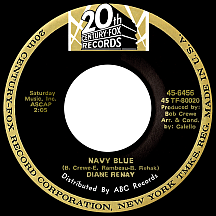DIANE RENAY
Navy Blue
One of the best teen singers of her era, Renee Diane Kushner was an only child from South Philadelphia, with a mother inclined to vicariously living the glamorous career she never had through her daughter and a father who owned a jewelry store and knew lots of prominent local folks. As a child, Renee constantly sang around the house to records, radio or TV - she would sing the grocery list if given the chance - and in 1958, at age 12, she had a few voice lessons with Artie Singer, a local bandleader and songwriter fresh from astounding success with "At the Hop" by Danny and the Juniors, a song he had cowritten, arranged and released on his own Singular label (leased to ABC-Paramount, it became the biggest hit of the entire year). He recognized her talent but suggested she wait a few years until her voice matured a bit.
She couldn't wait that long. At 14 she recorded a doo wop-style demo of James F. Hanley's '30s tune "Zing! Went the Strings of My Heart," recruiting four boys from school to do backing vocals. Though Renee kept mostly to herself and had few close friends, she craved attention. At 15 she entered a teen beauty pageant, placing second runner-up. By 1962, when she was 16, dad tipped her off that Peter DeAngelis (a well-known producer-arranger for some of Philly's hottest teen acts including Frankie Avalon and Fabian), a customer at his store, had agreed to meet the songstress who regularly rattled the walls of his home. Renee and her parents went to DeAngelis' house in New Jersey and she sang while he played piano. Pete recognized Renee's potential and helped get her in the door at Atlantic Records; label exec Jerry Wexler signed her to a limited deal guaranteeing no less than two single releases.
A little bending and twisting of her given name resulted in the inverted Diane Renay...meaning she had to get used to everyone calling her by a different first name! "Little White Lies," a post-adolescent rendering of Walter Donaldson's '30s tune, was a somewhat shaky first effort but received airplay on stations in Philadelphia and some nearby cities towards the end of 1962. Its spring '63 follow-up, on the other hand, was right in the teen-girl-groove of the time (typified by Shelley Fabares, Marcie Blane, Little Peggy March and freshly-minted New Jersey chart-topper Lesley Gore), thanks largely to the savvy of Bob Crewe, the former male-model-turned-record producer recently flush with the explosive success of Newark's 4 Seasons while overseeing the career of Tracey Dey, a teenage singer from Yonkers, New York. "Tender," a gently heart-tugging number delivered by Diane in an enticing spoken-and-sung manner (written by Crewe and 15-year-old newcomer David L'Heureux), couldn't miss (or could it?); by the end of the '63 school year it was a moderate hit in Philly, a pick-to-click in Pittsburgh and a bigger hit on the Great Lakes corner of PA (rising to number one on the "Top 60 Music Survey" at Erie's WJET). With a laundry list of stations soon on board, the song was a Keystone State smash certain to point westward, southward, all over, right? But that didn't happen. Somehow the song missed the national charts, winding up as a case study in the file marked "Regional Curiosities" under "Hits That Could Have Been."

Not to worry. Crewe believed Diane Renay had something special. For her, though, the experience brought with it a mix of emotions she hadn't foreseen: the thrill of making records, the excitement of hearing her song on the radio, the isolation of being shunned by schoolmates, an insecurity that kept her from asking anyone why they grouped together, whispering who-knows-what when she appeared in the hallway. Paranoia? Of the typical teenage kind, maybe. Another year of this? High school graduation couldn't come quickly enough! Atco dropped her after the second single; Crewe set her up with 20th Century-Fox Records, the recording arm of the major film studio. He and "Candy Girl" cohort Larry Santos composed a killer song, "Unbelievable Guy," which came alive as an energetic, assertive production with enormous hit potential. But the plan was sidetracked when Crewe, Eddie Rambeau and Bud Rehak came up with a cute ditty about a girl left behind by her 'steady boy' who said 'ship ahoy!'; "Navy Blue" was recorded in a few takes at the end of a session and turned out to be the side the label promoted. Too bad for "Guy," a strong track that could have been a hit, displaying a tougher, more confident vocal by Diane than the sweet, longing tone of "Navy Blue."
The single appeared late in 1963 and broke from coast-to-coast at the same time The Beatles impacted America, resulting in a number six Billboard hit that could have been number three if the Fab Four hadn't formed a triumvirate in the top five of March '64 ("Navy Blue" did reach number one on the Adult Contemporary, then called "Middle-Road," charts). Diane found herself in huge demand, appearing on stage decked out in a "navy girl" outfit (that she also donned for her album cover photo), going full-tilt with the gimmick that convinced everyone she was intent on nabbing a gob for good; it became her claim-to-fame, embedded further with the follow-up single, the Rambeau-Rehak retread "Kiss Me Sailor" that Diane called "Navy Blue Chapter Two," which hit the top 30 in May. She was so busy she didn't stop long enough to notice if the girls in school were still glaring at her or might perhaps act more friendly this time around; weightier issues were at hand, like hopping a plane every Friday afternoon to get to a scheduled venue, navigating through each weekend, sometimes not showing up at school until Tuesday and coming up with excuses for her counselors, who didn't really care since she'd be graduating soon, provided she could pull off a passing grade.
With high school off her to-do list, Diane experienced the summer of her life, making concert appearances throughout North America, cozying up to Bobby Rydell at the New York World's Fair, sharing a dressing room with The Supremes in Atlantic City and opening for The Rolling Stones at the San Antonio, Texas "Teen Fair" during the "bad boy" Brit band's first U.S. tour (not exactly smitten with them, she was a fan of the "cleaner" Beatles, who she considered the "opposite" of the Stones). Time was made for studio sessions with Bob Crewe in control, using top-notch backing singers including Ellie Greenwich (a successful songwriter who loved making records, whether she was lead, backup or hand-clapper) and 14-year-old Patti Austin (who made her first solo record the following year). "Growin' Up Too Fast" (cowritten by Crewe and Season Bob Gaudio) tapped into a timeless dilemma facing teenage girls ('Mama said we can't get married!'). "It's in Your Hands" (penned by Crewe and arranger Charles Calello) took an older, more adult-sounding approach in an attempt to sustain the middle-road, but it was an area unsuited to Renay. For a moment it appeared the 20th Century-Fox connection might lead to an acting career; the studio gave her a screen test, but nothing came of it.
The next single, "Watch Out, Sally!" (composed by Crewe, Sandy Linzer and Denny Randell), ranks among Diane's best efforts, a tough-girl tug-of-war over some guy named Tony (seemingly inspired by similar Shangri-Las drama-queen scenarios popular in the second half of '64); it ended up on the MGM label and, like the two 20th Century singles before it, had a brief national "Bubbling Under" run. Progress slowed after that, but not for lack of effort. Another 45 on MGM was followed by "Words," the summer '65 inaugural release on Crewe's New Voice label; the too-few New Voice efforts varied in dynamic approach, her brassier post-maritime hits showing unfulfilled promise.
There was a one-off single for United Artists, "Dynamite," and a dance version of the Jerome Kern-Oscar Hammerstein Showboat tune "Can't Help Loving That Man," then in 1969 she emerged again under Philly soul producer Thom Bell with a large-scale pop production of Harry Noble's "Hold Me, Thrill Me, Kiss Me" (swimming upstream, odds-wise, as the song had already been a major hit for Karen Chandler in '52 and Mel Carter in '65); the record, on Fontana, received a smattering of radio play from disc jockeys previously entangled in Diane's nautical spell or, perhaps, impressed by her persistence. But she left the business soon afterwards to check another project off her list of life's goals: she married and gave birth to a daughter, but after a time the "old feeling" returned. Diane Renay has since embraced her "fleeting" status as the "Navy Blue" girl; she made a few recordings for small labels during the 1980s, though she has since chosen to pack away the uniform and no longer performs in public.


